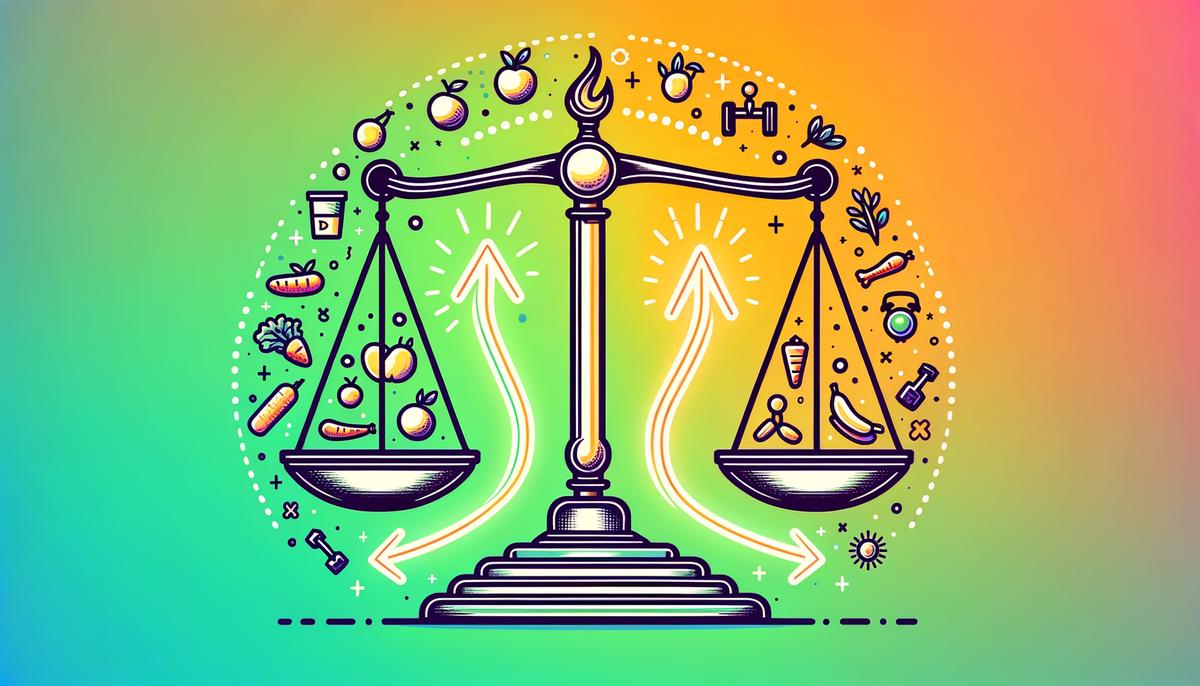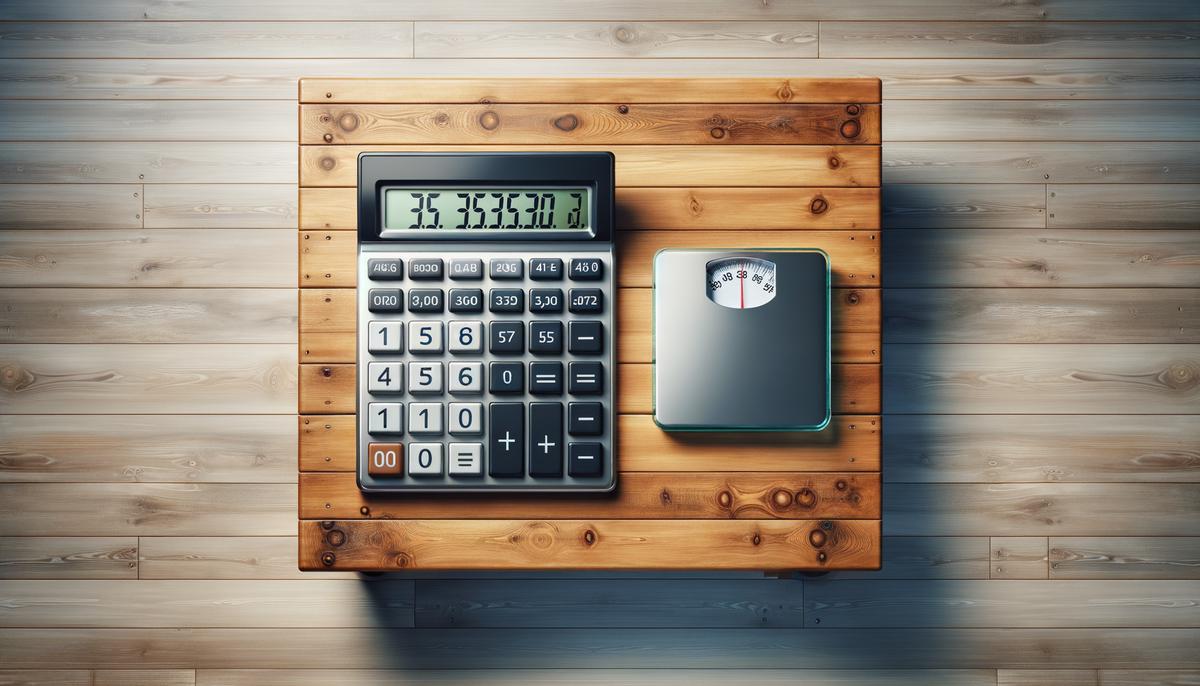When it comes to making changes in our weight, understanding the fuel our body needs and how it uses this fuel is crucial. Setting the right balance between what we consume and what we burn can lead to effective weight management. This article aims to explore the essentials of caloric deficit, macro tracking, and their roles in weight loss, giving you the insights you need to adjust your food intake and activity levels for a healthier lifestyle.
Understanding Caloric Deficit
Understanding Caloric Deficit and Its Role in Weight Loss
Embarking on a weight loss journey often seems like a puzzle. One key piece of this puzzle is something called a caloric deficit. Simply put, a caloric deficit happens when you consume fewer calories than your body uses up. This concept is crucial for shedding those extra pounds. Let’s dive into what a caloric deficit is and how you can use it to your advantage for weight loss.
What Is a Caloric Deficit?
Think of your body like a car that needs fuel (calories) to run. Every action, from breathing to jogging, uses up some of this fuel. A caloric deficit occurs when you give your body less fuel than it needs to carry out all its daily activities. In a move to fill this gap, your body turns to stored fat for energy, and as a result, you lose weight.
How Does It Lead to Weight Loss?
Picture your body’s energy balance as a scale. On one side is the energy you take in (what you eat and drink), and on the other is the energy you burn (through activities and basic bodily functions). For weight maintenance, you want to keep this scale balanced. To lose weight, you must tip the scale towards burning more energy than you consume. This creates a caloric deficit, prompting your body to use stored fat, leading to weight loss.
How to Achieve a Caloric Deficit
- Know Your Needs: First, figure out how many calories your body uses daily. Many online calculators can help estimate your energy needs based on factors like age, gender, weight, and activity level.
- Track Your Intake: Keep a food diary or use an app to monitor how many calories you’re eating. Awareness is the first step toward making changes.
- Eat Mindfully: Choose foods that are filling but low in calories. Think vegetables, fruits, lean proteins, and whole grains. These foods satisfy hunger without using up all your calorie “budget.”
- Move More: Any form of physical activity, from walking to gardening, helps burn calories. The more active you are, the higher your daily calorie use, making it easier to create a deficit.
- Adjust Slowly: Don’t rush into a big calorie cut. Start by reducing your intake slightly and gradually. This approach helps avoid feelings of deprivation or potential binge eating.
Remember, while creating a caloric deficit is important for weight loss, it’s equally vital to do so healthily and sustainably. Crash diets or excessive exercise are neither successful long-term strategies nor conducive to overall well-being. The goal is to find a balance that works for you, where you’re losing weight at a healthy pace without sacrificing nutritional needs or quality of life.
Achieving weight loss is about making smart, mindful choices that tip the energy balance scale in your favor. With patience and consistency, establishing a caloric deficit can be a powerful tool in reaching your weight loss goals.

Calculating Daily Caloric Needs
Now, let’s dive into calculating your daily caloric needs – an essential step to tailoring your nutrition plan right at home, without any fancy tools. Understanding how many calories you need each day is like having a roadmap for your weight loss journey. It tells you how much fuel your body requires to function optimally without venturing into excess that gets stored as fat. This guide will show you a straightforward method to get your numbers right.
First off, get familiar with the Basal Metabolic Rate (BMR). Your BMR is the number of calories your body needs to perform basic life-sustaining functions, like breathing, circulation, and cell production. Think of it as the amount of fuel your engine needs to run while it’s idle.
To estimate your BMR, you can use the Harris-Benedict Equation, which factors in your sex, age, weight, and height. Here’s the quick rundown:
For men: BMR = 88.362 + (13.397 × weight in kg) + (4.799 × height in cm) – (5.677 × age in years)
For women: BMR = 447.593 + (9.247 × weight in kg) + (3.098 × height in cm) – (4.330 × age in years)
Now, moving from the idle to the active, we bring in the Physical Activity Level (PAL). Your lifestyle and daily activities significantly influence your total caloric needs. The PAL factor categorizes your physical activity into sedentary, lightly active, moderately active, or very active.
Multiply your BMR by the corresponding PAL value:
– Sedentary (little or no exercise): BMR × 1.2
– Lightly active (light exercise/sports 1-3 days/week): BMR × 1.375
– Moderately active (moderate exercise/sports 3-5 days/week): BMR × 1.55
– Very active (hard exercise/sports 6-7 days a week): BMR × 1.725
– Extra active (very hard exercise/sports & a physical job): BMR × 1.9
This multiplication gives you your Total Daily Energy Expenditure (TDEE), a.k.a., the total number of calories you need each day to maintain your current weight, considering your activity level.
Now here’s the golden nugget: to lose weight, you need to consume fewer calories than your TDEE. A safe rule of thumb is to aim for a deficit of 500 calories per day to potentially lose about a pound a week. Remember, drastic calorie reductions aren’t the way to go. They can mess up your metabolism, making weight loss harder in the long run.
In sum, knowing how to calculate your daily caloric needs empowers you to tailor your diet for effective weight loss. Adjust your calorie intake based on your lifestyle changes or weight loss progression, and remember – every person’s body is different and might require a tweak in the plan. Keep it balanced, keep it healthy, and let the journey to a better you be a joyful one.

Tracking Calories and Nutrients
Tracking Your Macros: The Key to Unlocking Weight Loss Success
Hey there, health warriors! Ever wondered why some folks seem to drop pounds effortlessly while others hit a wall? It’s not just about cutting calories; it’s about tracking what’s in those calories. That’s right, we’re talking about the macronutrients – proteins, fats, and carbohydrates. These bad boys play a massive role in how your body functions, loses weight, and feels throughout the day. So, grab a notebook or your favorite app, because we’re diving into the world of macros!
Why Macros Matter More Than You Think
Imagine your body is a fancy car. To keep it running smoothly, you need the right kind of fuel. Proteins are your body’s building blocks, repairing tissues and keeping your immunity in check. Carbohydrates are the go-to energy source, fueling your brain and muscles, especially during those sweaty workouts. And fats? They’re not the villain they were once made out to be. Healthy fats keep you full, cushion your organs, and help absorb vital vitamins.
Finding Your Perfect Macro Mix
Here’s the deal: there’s no one-size-fits-all ratio. Your unique mix depends on your lifestyle, weight loss goals, and how your body reacts to different foods. Start with a baseline—many experts suggest aiming for 50% carbs, 30% protein, and 20% fats for a balanced diet. But feel free to tweak it! More active? Bump up the carbs. Looking to gain muscle? Pile on the protein. The key is to adjust based on your body’s feedback and your progress towards those goals.
Turn Into a Macro-Tracking Ninja
Now, you might think tracking macros is a chore, but it’s like a secret weapon for weight loss. It makes you super aware of what you’re munching on and helps avoid those sneaky calories that add up from mindless snacking. Start simple: Read labels, use a food tracking app, or even old-school it with a pen and paper. The goal is to see where your calories are coming from and adjust as you go.
Avoid the “Empty Calories” Trap
We’ve all been there, reaching for that low-cal snack that’s all sugar and no substance. It might fit your calorie count, but it’s doing zilch for your nutrition. Instead, choose foods rich in nutrients that will satisfy your hunger and keep you energized. Think whole grains over white bread, fresh fruits instead of sugary snacks, and lean meats over processed ones. These choices not only help with weight loss but also make you feel fantastic.
Listen to Your Body
As you dive into macro tracking, remember, your body knows best. If you’re feeling sluggish or constantly hungry, it might be time to reassess your macro ratios. Perhaps you need more complex carbs for energy or more protein to feel satiated. Adjust, listen, and learn. Weight loss is not just a physical journey but a tuning process with your body’s needs and signals.
Get Creative in the KitchenHere’s the fun part: experimenting with recipes and food combinations to hit your macro goals. Got a high protein target? Whip up a chicken stir-fry packed with veggies. Need to fit in more healthy fats? Avocado toasts or nuts are your go-to. The possibilities are endless, and who knows, you might just discover your new favorite dish.
Celebrate Small Wins & Stay Flexible
Finally, remember this journey is about progress, not perfection. Celebrate the small wins, like choosing a healthy lunch over fast food or hitting your water intake for the day. And if you slip up? No biggie. Every meal is a new opportunity to align with your goals. Stay flexible, adjust as needed, and keep moving forward.
There you have it, folks! By keeping a keen eye on your macros, you’re not just losing weight; you’re stepping into a healthier, more balanced lifestyle. Ready, set, track!

Embarking on a path towards a healthier weight involves more than just counting calories; it’s about making informed choices about the nutrients you consume and understanding how they fuel your body. Tracking macros can be a transformative tool, turning the foods you eat into allies in your weight loss efforts. By focusing on the balance of proteins, fats, and carbohydrates, you set yourself up for success, not just in losing weight but in achieving a more balanced and vibrant health. Embrace this approach with an open mind and a commitment to gradual, consistent changes, and watch as it brings you closer to your goals, meal by meal, step by step.
Generate high-quality content with Writio, an AI content writer. This article was written by Writio.
Leave a Reply